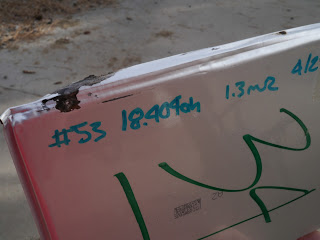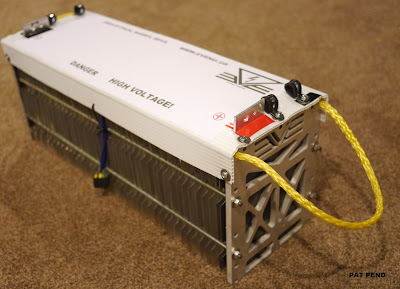Getting there is half the fun
On
Wednesday I found out that PPSCC was having an autocross on Saturday so I
decided why not and started making plans.
I was originally going to buy a car dolly to tow the Miata but after
calling all the ads on CL only one wasn't already sold. On Friday after work I checked it out and
found out there was a good reason that dolly hadn't sold, it was scary. So I had to figure out another plan. I checked recargo and there was a Level 2 at
a Walgreens a couple miles away from the event. With a Level 2 it would only
take me an hour to top of my pack but it was easier to leave it overnight. We
called the store and they said it would be no problem leaving it to charge
overnight. The week before I had just happened to order the parts for a J1772
charge port so at 7pm I wired it up and drove it down.
Apparently
things were going to smoothly because just a few miles down the road a deer
jumped into the road in front of me. Luckily I was only driving about 35mph and
just pushed the deer forward a foot and it ran off. Because the speed was low the damage was
light limited and after a quick check I continued driving to the charge
station. However when I went to charge I
found that the charger wasn't working with my port.
I later figured
out that it wasn't liking my non-isolated PFC-20 and tripping the GFCI. There was no 110V plug on the charger but
down the road were some more chargers and went to try them. Keeping in the
theme for the night they were wired up but not activated yet. Luckily my wonderful wife spotted a 110V
outlet on a nearby light pole 30' away from those level 2s was. Great!
But I had
left my 110 plug on my workbench a 30 minute drive back! D'oh! At this point common sense would have been to
give up and call it a night but a quick run into Walgreen's along with a few
minutes turned a power-strip, wire nuts, and some electric tape into a ad-hoc
charge chord and left the car to charge overnight and we finally got to bed
shortly after midnight.
Track time!
The next
morning was time for some racing! The
car passed through tech and got a lot of questions from fellow racers.
There were
a lot of nice fast cars out there Focus ST, FR-S, 370z, '13 Boss 302, several
Miatas ranging from stock to turbos and race prepped full caged, and in general
a lot of cool mustangs since PPSCC did the event in conjunction with the local
mustang club.
Everyone
was really nice but unfortunately my co-driver wasn’t allowed.
The autocross was a fun set-up with a nice
high speed chicane and made a U-turn with a broken sweeping 270 that was a lot
of fun to steer through with the right foot.
:) Unfortunately my mount for my
camera wasn’t stiff enough to handle the g forces so no in car video but I am
going to have a GoPro silver for next weekend’s race at PPIR.
I have to
say that my favorite part of driving the car is the throttle control. If I came in too hot to a corner I could *save*
it by hitting the gas and bringing the rear of the car around. The Soliton1 and the 9” motor just delivered exactly
the torque I wanted, whenever I asked for it.
I am actually toying with the idea that my next project will be an
electric drift car.
I have to say
that I am not a great driver. I haven’t raced in 6 years and I was a slow
driver way back then. Each lap I remembered how to drive and dropped almost a
second each time around. I felt the car
could have gone a lot faster but turns out the car was doing very well.
I am running the Soliton1 aircooled and it worked
wonderfully. Starting in second gear the
initial launch is a little off compared to what is best described as the
feeling of thrust once it’s rolling. Looking at the logger I am being limited
by the slew rate at launch for the second quarter of a second. I tired bumping it to 3000 but I need to do
some more tweaking (mostly of the driver) and testing to get a good launch. I do want to get some more weight on the
rear wheels. I am going to move the
charger to the back and try to get my 4th module back together and
installed.
I was busy
driving and working corners but my wife said when they posted the times
everyone on the side lines were saying "I can't believe how fast that
electric Miata is, it beat most of the cars out here." which made my day
even better. Looking at the results out
of the 44 racers 4 of them solidly beat my best time including an awesome
sounding red mustang, a race rX7, a black mustang, and new 370z getting times
of 42.5-44.5. I was within a few tenths
of another 5 racers as it ended up that a bunch of us managed times right
around 45.5. An overall 9th
out of 44 was far better then I was thinking I was going to manage. Even more surprising was beating a new Boss
302, Focus ST and FR-S, which are some sweet cars. And that was with me behind the wheel and 70%
power. For the next event I am going to
bump the power from 800 to 1000 amps and move the voltage up to 155V to give me
more pull off the line and a tiny bit better top end.
Working
corners my favorite two cars to watch were a really cool tuned up orange focus
hatch and that fast red mustang with the white stripes. Both sounded awesome. I need to put some open headers on my 9”
motor.J Needless
to say I was really happy with the car's performance and really appreciative to
PPSCC for putting on the event and everyone who showed up.
















































